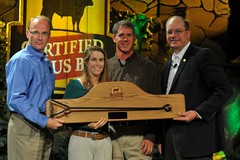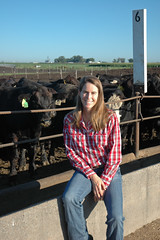Our house has continually rising levels of Estrogen. I like to tease my husband that he “always wanted to be surrounded by women, and now he is”. As the only male in a house of four women (four opinionated women…), he does at times feel a little bit overwhelmed…We have three male (neutered) cats, and two male (gelded) horses but that falls significantly short of balancing the circulating estrogen (and resulting drama) produced by the two legged girls in his house!
All jokes aside, I would like to take a couple of posts to try and demystify the topic of growth hormone use in my beef cattle. What are they? How do I use them? At what level do I use them? Why do I feel confident that using them is a good decision?

I feed the beef that I produce to my family every day, so I want to be confident that what I am feeding to them is healthy…
As a college graduate with a major in physiological psychology, I have a basic understanding of the role that hormones play in the lives of both humans and animals.
As a cattle caregiver, I have a vested interest in understanding the role that growth promoting hormones play in the welfare of my cattle and the efficient use of natural resources to produce beef.
As a mother of three developing girls, I have a vested interest in understanding how the use of hormones in beef cattle affects the beef that I feed to my children every day.
- What are they? Hormone implants are small doses of hormones that act on the pituitary gland (in cattle) and cause it to produce more somatotropin which is the animal’s own natural growth promoting agent. This allows the calf to gain more weight with an improved dry matter feed conversion (which means that it takes fewer pounds of feed to create more pounds of beef).
- How do I use them? Calf #718 received a “calf” implant at branding time (the same time that he was castrated). He then received another low dose implant when he arrived at the feed yard eight months later. He received his final implant approximately 80 days prior to harvest. These hormone “implants” are administered according to FDA (Food and Drug Administration) and Beef Quality Assurance guidelines, and are placed in the calf’s ear.

The implant is administered the middle third section of the back of the animal’s ear. This administration site is discarded at harvest time and never enters the food production chain.
I work with both my nutritionist and veterinarians (you “met” them all in the last couple of weeks), to select appropriate hormone implants and the timing in which they are administered.
- At what level do I use them? The first implant that Calf #718 received immediately following castration contained 10mg (milligrams) of Estradiol and 100mg of Progesterone. The hormone implant given to Calf #718 eight months later, upon arrival at the feed yard, was 36mg of zeranol. The final hormone implant that the calf received contained 24mg of Estradiol and 120mg of Trenbolone Acetate approximately 80 days prior to harvest.
He received these implants in order to replace some of the circulating hormones that were lost due to castration. You might ask, “Why did you castrate the animal and then give him a hormone implant? Why didn’t you just leave the animal “sexually intact” and use the hormones that his body produced?”
The short answer is that I can do a better job managing the hormone levels and their effect on both the animal and his meat by castrating the animal at a young age, and then putting a portion of the hormones lost due to castration back into the animal at timely intervals.
A more moderate level of circulating hormone (which occurs with the correctly timed and administered hormone implant) allows the animal to gain weight efficiently (using fewer natural resources), and produce what I believe is a more tender beef product. It also makes the animal less aggressive than his “intact” herd mate which is a “handling safety” benefit.
Perhaps the most important question of all is: Why do I feel confident that using them is the right thing to do? Click here to see a follow up post answering this questions in addition to providing you will some statistics about the different levels of hormones in beef and other foods that we eat. https://feedyardfoodie.wordpress.com/2011/08/30/unfamiliarity-with-technology-breeds-distrust-and-misunderstanding%E2%80%A6/

My beef needs to be healthy and come from animals that are efficient in their use of natural resources…It nourishes my children and ensures their future.
I hope that you will join me in feeling good about sharing a great tasting and healthy beef meal with your family!













Here are some more facts supporting castration and hormone implantation: Estrogen in bull meat is equal to that of estrogen in cow meat at 1st trimester of pregnancy. Testosterone in bull meat is over 30x that in both non-implanted steer meat and implanted steer meat, given that beef from implanted and non-implanted steers contain insignificantly different levels of testosterone.
Testosterone levels in meat:
0.34–0.73 mg/kg for bulls
0.069 mg/kg in muscle tissue from heifers
0.01–0.14 mg/kg detected in muscle from steers, both implanted and non-implanted.
Thanks to modern practices such as castration and implantation (i.e., no bull meat), we have more beef produced per animal, we have a more tender product, and finally, we have less hormone exposure to estrogen and testosterone in beef.
My sources are from the following documents:
Human Safety of Hormone Implants Used to Promote Growth in Cattle http://fri.wisc.edu/docs/pdf/hormone.pdf
Fritsche and Steinhart, 1998 http://jas.fass.org/content/76/6/1621.full.pdf
Hendricks et al., 1983 http://jas.fass.org/content/57/1/247.full.pdf
…with plenty of other sources on my blog post, http://foodthinkforum.blogspot.com/2011/05/going-hormonal-over-beef.html
Great post, Anne!
~Cassie
Thanks Cassie for giving us data and research to look at. You did a great job “filling in the holes” for me with some informative numbers!
As a college graduate with a major in physiological psychology.. did you know, In premenopausal women the majority of estrogen produced by the body is estradiol (produced primarily in the ovaries), while in postmenopausal women estrone (produced in fat cells) is the type of estrogen present in the greatest amount; however, the body is able to convert one type of estrogen into another to a certain extent. Because of the limited research into potency, delivery methods and conversion of the various estrogens, a valid scientific understanding of compounded estrogen products has not been achieved.Synthetic estradiol, taken orally, splits when absorbed in the gastrointestinal tract and delivers bioidentical estradiol to the bloodstream. Not to mention, Less common (but serious) side effects of all post-menopausal estrogens include increased risk or severity of breast, ovarian or uterine cancer, stroke, heart attack, blood clots, dementia, gallbladder disease, high blood pressure, liver problems, high blood sugar, fluid retention, enlargement of benign tumors (fibroids) of the uterus, a spotty darkening of the skin, especially on the face (melasma), and vaginal yeast infection, Sourced in medical reports.
now i bet you delete the truth and if you do.. I will never touch meat again
Hi “I’m Not Fooled Easy”,
Thanks for stopping by my blog. I am a little bit confused as to what your question is. I am also a little bit disappointed that you did not use your real name when you signed in and then ended your comment the way that you did.
I have tried very hard to structure my blog site such that we can have respectful conversations and learn from each other. I would like to ask that you abide by this. If you have a question, then please ask it and I will do my best to answer it. I genuinely hope that you found some useful information in my posts–it is my intent to share my life raising cattle and kids in the heartland of the United States.
Have a great day,
Anne
You seem to understand the mix of chemicals in your cattle’s bodies, but have you considered the added chemicals from commercial feeds/grains, and the effects of GM grains?
Hi Jerry,
That is a great question, and I am trying to do some homework so that I can give you a balanced and accurate answer. Please look for a post in the next few weeks that addresses your question.
Thanks for stopping by and leaving a question/comment.
All the best,
Anne
Pingback: Ask a Farmer: Are feedlot cattle fed antibiotics and hormones? | Agriculture Proud
Pingback: To the Curious Consumer |
Pingback: Winter Chores… | Feed Yard Foodie
Hello i am kavin, its my first occasion to commenting anyplace, when i read this paragraph
i thought i could also create comment due to this brilliant
paragraph.
Pingback: Let’s Visit: Hormones – Cow Country
Good points but the skeptic in me wonders “Would you also give yourself or kids hormones?” Why or why not